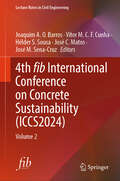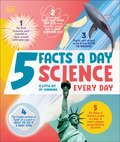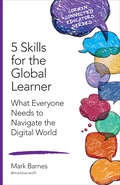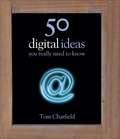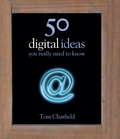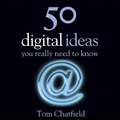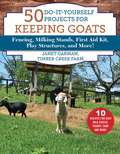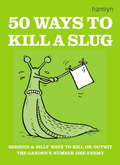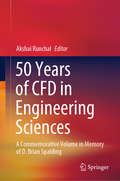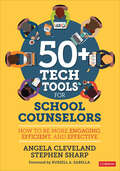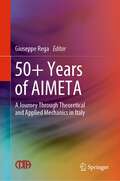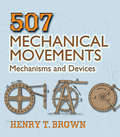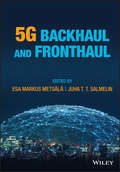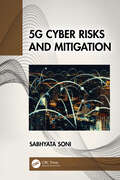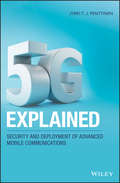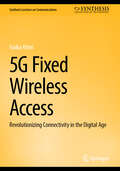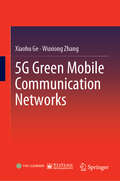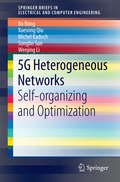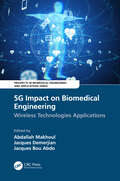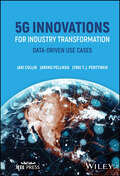- Table View
- List View
4th fib International Conference on Concrete Sustainability: Volume 2 (Lecture Notes in Civil Engineering #574)
by José C. Matos Hélder S. Sousa Vítor M. C. F. Cunha Joaquim A. O. Barros José M. Sena-CruzThis volume presents the proceedings of the fib International Conference on Concrete Sustainability, held in Guimarães, Portugal on 11–13 September 2024. It covers topics such as concrete and advanced materials, structural performance and design, construction methods and management, durability, life cycle design, through-life management and care, resilience, dismantlement, reuse and recycling, & innovation in buildings and civil structure. fib (The International Federation for Structural Concrete) is a not-for-profit association whose mission is to develop at an international level the study of scientific and practical matters capable of advancing the technical, economic, aesthetic, and environmental performance of concrete construction.
5 Facts a Day Science: A Little Bit of Learning Every Day
by DKAre you ready to have your mind blown? Wow all your friends and family with 5 jaw-dropping facts about science each day.Discover 5 facts a day, 5 days a week with this exciting science book for children aged 8-12. With five facts a day, every day of the year, that’s more than 1,825 nuggets of knowledge!From rocks to robots, and cells to solar systems, this eye-opening book covers more than 250 different science topics in an easy-to-read, entertaining, and bite-sized way to build on your knowledge as you go. Enjoy learning something new every day or just dip in and out for fun.This science book for children offers: An engaging layout, with different subjects and facts to explore every day.More than 250 different science topics, from electromagnetism to evolution.Fun, educational content for children to have fun whilst learning about science.Did you know that you can't burp in space? Or that bananas are slightly radioactive? Or that there are more trees on Earth than there are stars in our solar system? Discover the science behind all these facts and much more with 5 Facts a Day: Science.
5 Skills for the Global Learner: What Everyone Needs to Navigate the Digital World (Corwin Connected Educators Series)
by Mark D. BarnesTap the power of digital learning! In today’s digital world, distance and cultural differences are inconsequential. Technology empowers students and provides them with unlimited resources and opportunities. With this easy guide, you’ll learn the five essential skills to transform students into global learners: Creating and sharing digital information Using social media Digital publishing Building a personal learning network Using aggregators to create, maintain, and share content Loaded with tips and examples for using PLNs, Facebook, Twitter, Skype, YouTube, Jing, and other essential tools, this breakthrough guide to incredible learning opportunities will keep you and your students a step ahead!
5 Skills for the Global Learner: What Everyone Needs to Navigate the Digital World (Corwin Connected Educators Series)
by Mark D. BarnesTap the power of digital learning! In today’s digital world, distance and cultural differences are inconsequential. Technology empowers students and provides them with unlimited resources and opportunities. With this easy guide, you’ll learn the five essential skills to transform students into global learners: Creating and sharing digital information Using social media Digital publishing Building a personal learning network Using aggregators to create, maintain, and share content Loaded with tips and examples for using PLNs, Facebook, Twitter, Skype, YouTube, Jing, and other essential tools, this breakthrough guide to incredible learning opportunities will keep you and your students a step ahead!
50 Digital Ideas You Really Need to Know
by Tom ChatfieldWe are in the throes of a revolution, yet most of us are so disorientated by the rapid pace of technological and cultural change that we find it difficult to understand what's going on. 50 Digital Ideas you Really Need to Know aims to provide a clear path through the confusion and misinformation surrounding those technologies that, for better or for worse, are transforming the world we live in and even the sort of people we are.Leading technology writer Tom Chatfield is a sure-footed guide to the seminal digital phenomena of our time, from the basic browsers that we use to surf the web and update our status on social networking sites, through to the implications for privacy of our permanently distracted world, to the culture jamming that is making it increasingly difficult for traditional power structures to impose their authority. Whether plumbing the depths of the deep web that represents well over 99 percent of the internet and remains inaccessible to most search engines, to digital distribution which threatens to sweep away entire industries, to the augmented reality that will soon change the very way we interact with the world, this is an indispensable road map for the inevitable journey to a digital future.From malware to mashups; from spam to the semantic web; and from email to avatars, this book is essential reading for anyone who wants to understand the profound social and behavioural changes wrought by the emerging digital age.
50 Digital Ideas You Really Need to Know
by Tom ChatfieldWe are in the throes of a revolution, yet most of us are so disorientated by the rapid pace of technological and cultural change that we find it difficult to understand what's going on. 50 Digital Ideas you Really Need to Know provides a clear path through the confusion and misinformation surrounding those technologies that, for better or for worse, are transforming the world we live in and even the sort of people we are.Leading technology writer Tom Chatfield is a sure-footed guide to the seminal digital phenomena of our time, from the basic browsers that we use to surf the web and update our status on social networking sites, through to the implications for privacy of our permanently distracted world, to the culture jamming that is increasingly being used by protest movements, this is essential reading for anyone who wants to understand the profound social and behavioural changes wrought by the emerging digital age.
50 Digital Ideas You Really Need to Know (50 Ideas You Really Need to Know series)
by Tom ChatfieldWe are in the throes of a revolution, yet most of us are so disorientated by the rapid pace of technological and cultural change that we find it difficult to understand what's going on. 50 Digital Ideas you Really Need to Know provides a clear path through the confusion and misinformation surrounding those technologies that, for better or for worse, are transforming the world we live in and even the sort of people we are.Leading technology writer Tom Chatfield is a sure-footed guide to the seminal digital phenomena of our time, from the basic browsers that we use to surf the web and update our status on social networking sites, through to the implications for privacy of our permanently distracted world, to the culture jamming that is increasingly being used by protest movements, this is essential reading for anyone who wants to understand the profound social and behavioural changes wrought by the emerging digital age.
50 Digital Ideas You Really Need to Know: You Really Need to Know (50 Ideas You Really Need to Know series)
by Tom ChatfieldWe are in the throes of a revolution, yet the rapid pace of technological and cultural change makes it difficult to understand what's going on. 50 Ideas You Really Need to Know: Digital provides a clear path through the misinformation surrounding those technologies that are transforming the world. Leading technology writer Tom Chatfield provides a sure-footed guide to the seminal digital phenomena of our time: from the basic browsers that we use to surf the web, to the implications for our own privacy. From plumbing the depths of the deep web that represents well over 99 per cent of the internet and remains inaccessible to most search engines, to digital distribution that threatens to sweep away entire industries, this is an indispensable road map for our journey to a digital future.(P)2011 Quercus Editions Ltd
50 Do-It-Yourself Projects for Keeping Chickens: Chicken Coops, Brooders, Runs, Swings, Dust Baths, and More!
by Janet GarmanGet ready to jump into the world of chickens, one DIY project at a time. Owning and raising chickens doesn’t have to be an expensive hobby. With imagination, simple tools, and salvaged or bargain materials, you can make everything your flock needs for their health and safety.Buying a chicken coop can be a major expense. Follow the steps provided in the book to retro fit an existing structure into a chicken palace fit for the fanciest hens. Brooders, grow out pens, and chicken runs can easily be pulled together and give your feathered family a safe place to scratch and peck.If your chickens want fun activities, create boredom busters with the directions for a chicken swing, dust bath, outdoor roosts, front porches, and resting perches. Are you planning to raise your own sustainable flock? Building a nesting box area fit for the best broody is included. You can even set up a maternity ward and brooder pen in the coop. Dropping boards to dust baths, feeding stations to first aid, read and learn the simplest ways to provide the infrastructure and fun that your chickens need to grow and thrive. After all the project building, and chores are done, treat your flock to a delicious seasonal recipe with one of the recipes included.From beak to talon, you’re ready to tackle the needs of your flock with 50 DIY Projects you can create on a limited budget. Let’s get started!
50 Do-It-Yourself Projects for Keeping Goats: Fencing, Milking Stands, First Aid Kit, Play Structures, and More!
by Janet GarmanBuild Fences, Make Goat Milk Soap, Create Goat Play Structures, and Much More! Get ready to jump into the world of goats, one DIY project at a time. Owning and raising goats doesn't have to be an expensive venture. With imagination, simple tools, and salvaged or bargain materials, you can make everything your goats need for their health, safety, and entertainment. Packed with useful information for goat owners, you'll learn about breeds, housing, nutrition, and more. Plus find instructions to learn how to: Build fencesConstruct a hay storage areaNaturally control harmful weeds in the pastureMake natural worm prevention supplementsBuild a dehorning boxCreate goat play structuresMake yogurt, cheese, lotion, soap, and moreBake goat treatsAnd more!From horns to tail, you're ready to tackle the needs of your goat herd with 50 DIY Projects you can create on a limited budget. Let's get started!
50 Ways to Kill a Slug
by Sarah FordAre you being bullied by a mollusc that slimes all over your garden and munches through your favourite delphinium? Are you worried about using slug pellets for fear of endangering local wildlife? Take a stand against slugs with 50 alternative, organic, natural, chemical and humane solutions to slug problems. Trick, flick and frighten slugs out of your garden, leaving you with pest-free plants. Stop slugs in their tracks and make slimy trails a thing of the past.
50 Years of CFD in Engineering Sciences: A Commemorative Volume in Memory of D. Brian Spalding
by Akshai RunchalProf. D. Brian Spalding, working with a small group of students and colleagues at Imperial College, London in the mid-to late-1960’s, single-handedly pioneered the use of Computational Fluid Dynamics (CFD) for engineering practice.This book brings together advances in computational fluid dynamics in a collection of chapters authored by leading researchers, many of them students or associates of Prof. Spalding. The book intends to capture the key developments in specific fields of activity that have been transformed by application of CFD in the last 50 years. The focus is on review of the impact of CFD on these selected fields and of the novel applications that CFD has made possible. Some of the chapters trace the history of developments in a specific field and the role played by Spalding and his contributions. The volume also includes a biographical summary of Brian Spalding as a person and as a scientist, as well as tributes to Brian Spalding by those whose life was impacted by his innovations. This volume would be of special interest to researchers, practicing engineers, and graduate students in various fields, including aerospace, energy, power and propulsion, transportation, combustion, management of the environment, health and pharmaceutical sciences.
50+ Tech Tools for School Counselors: How to Be More Engaging, Efficient, and Effective
by Angela Cleveland Stephen SharpDigital tools that will transform your practice Educating students in the 21st century is about more than preparing them for work in the digital age; it′s also about connecting with the whole student and transcending barriers. Written for school counselors and other education professionals, 50+ Tech Tools for School Counselors provides insightful descriptions of digital tools that can be used daily to not only enrich intervention and instruction but also guide decision-making, streamline work, enhance communication, and promote happier students. Readers will find: a framework for leadership and advocacy through the lens of technology vignettes demonstrating implementation and quotes from students and other stakeholders step-by-step guides and checklists perspectives from counselors around the country that provide a peer-to-peer feel narratives, technical descriptions, and diagrams School counselors are often unsure or unaware of the myriad of existing tech tools. This book will help them enhance their practice, feel more confident, spend less time on paperwork, and enable today’s students to achieve success in school and access information on college and careers.
50+ Tech Tools for School Counselors: How to Be More Engaging, Efficient, and Effective
by Angela Cleveland Stephen SharpDigital tools that will transform your practice Educating students in the 21st century is about more than preparing them for work in the digital age; it′s also about connecting with the whole student and transcending barriers. Written for school counselors and other education professionals, 50+ Tech Tools for School Counselors provides insightful descriptions of digital tools that can be used daily to not only enrich intervention and instruction but also guide decision-making, streamline work, enhance communication, and promote happier students. Readers will find: a framework for leadership and advocacy through the lens of technology vignettes demonstrating implementation and quotes from students and other stakeholders step-by-step guides and checklists perspectives from counselors around the country that provide a peer-to-peer feel narratives, technical descriptions, and diagrams School counselors are often unsure or unaware of the myriad of existing tech tools. This book will help them enhance their practice, feel more confident, spend less time on paperwork, and enable today’s students to achieve success in school and access information on college and careers.
50+ Years of AIMETA: A Journey Through Theoretical and Applied Mechanics in Italy
by Giuseppe RegaThe book retraces the history of the Italian Association of Theoretical and Applied Mechanics (AIMETA) since its establishment in 1965. AIMETA is the official Italian association of mechanics adhering to IUTAM (International Union of Theoretical and Applied Mechanics), which organizes and coordinates a meaningful number of research activities, the most important of which are the biennial National Congress and the internationally renowned journal “Meccanica”, published by Springer. Besides collecting and organizing all related important data and information, as far as possible, by distinguishing among the five scientific areas – general mechanics, solids, structures, fluids, machines – encompassed by AIMETA, the history of the association is assumed as a proper perspective to overview the evolution of theoretical and applied mechanics in Italy over about the last fifty years. This is accomplished in the first part of the book. with also a specific focus on the mechanics of solids and structures, where the biographies of a meaningful number of recognized Italian scholars of mechanics in all areas are also provided, along with testimonials and memories by a few senior people meaningfully involved with AIMETA and Italian mechanics. The second part gives an account, although unavoidably incomplete, of recent developments of mechanical sciences in Italy, as reflected also in the activities of AIMETA and with reference to the international context. Contributions by a number of invited senior scholars, still very active, consist of overviews on some scientific themes in the various areas, summaries of achievements of research groups, expressions of research viewpoints, prospects for future developments.
507 Mechanical Movements: Mechanisms and Devices
by Henry T. BrownEpicyclic trains, oblique rollers, trip hammers, and lazy-tongs are among the ingenious mechanisms defined and illustrated in this intriguing collection. Spanning the first century of the Industrial Revolution, this 1868 compilation features simplified, concise illustrations of the mechanisms used in hydraulics, steam engines, pneumatics, presses, horologes, and scores of other machines.The movements of each of the 507 mechanisms are depicted in drawings on the left-hand page, and the facing page presents a brief description of the item's use and operation. Ranging from simple to intricately complex, the mechanisms offer a fascinating view of the variety of small components that constitute complex machinery. A detailed index provides easy reference to specific mechanisms.Inventors, tinkerers, and anyone with an interest in the history of invention and technology will find this volume a treasury of information and inspiration.
52 Unique Techniques for Stocking Food for Preppers: A Strategy a Week to Help Stock Your Pantry for Survival
by David NashAre you and your family self-reliant? Will you be able to provide for them and keep them safe? The best way to prepare for the future is not through fancy tools and gadgets--it’s experience and knowledge that will best equip you to handle the unexpected. However, it doesn’t matter how prepared you are for disaster, if you run out of food you will soon run out of time. Everyone begins somewhere, especially with learning how to stock your pantry for an indefinite period of time. In 52 Unique Techniques for Stocking Food for Preppers, you’ll find a project for every week of the year, designed to teach you the fundamentals of canning and preserving any sort of food as safely as possible. Self-reliance isn’t about building a bunker and waiting for the end of the world. It’s about making sure you have enough food to feed your family should the worst happen. 52 Unique Techniques for Stocking Food for Preppersis the ultimate instructional guide to preparing food and making sure that it keeps. It is a must-have book for those with their eye on the future.
5G Backhaul and Fronthaul
by Esa Markus Metsälä Juha T. T. Salmelin5G BACKHAUL AND FRONTHAUL In-depth coverage of all technologies required for deployment and further evolution of 5G mobile network backhaul and fronthaul In this book, a team of communications technology experts deliver an up-to-date and technical discussion of 5G backhaul and fronthaul, preparing readers for the deployment of 5G technologies, covering the technologies essentials, and offering views of further 5G backhaul and fronthaul evolution. 5G Backhaul and Fronthaul serves both advanced-level experts with senior roles in organizations who are already proficient in these technologies, and general interest readers seeking a primer on what these technologies can provide. Readers will also find: Thorough introductions to 5G backhaul and fronthaul, as well as selected industry forums and activities Analysis of high-level requirements for 5G backhaul and fronthaul and 5G network architecture In-depth explorations of wireless backhaul and fronthaul access technologies, including fiber optic and wireless technologies, network security, network slicing, IP VPNs, Ethernet services, time sensitive networks and shared transport Practical treatments of the functions and services provided by backhaul and fronthaul Coverage of new 5G enterprise, industrial and smart city deployments Perfect for mobile network industry professionals, 5G Backhaul and Fronthaul will also earn a place in the libraries of people with an interest in 5G technologies, fiber technologies, IP and security, Ethernet, mobile network synchronization and mobile network performance.
5G Cyber Risks and Mitigation
by Sabhyata Soni5 G technology is the next step in the evolution of wireless communication. It offers faster speeds and more bandwidth than 4G. One of the biggest differences between 4G and 5G is that 5G will be used for a wider range of applications. This makes it ideal for applications such as autonomous vehicles, smart cities, and the internet of things. This means that there will be more devices connected to 5G networks, making them more vulnerable to cyber attacks. However, 5 G also introduces new cyber risks that need to be addressed. In addition, 5 G networks are expected to be much more complex, making them harder to secure. 5G networks will use new technologies that could make them more vulnerable to attack. These technologies include massive MIMO (multiple input, multiple output), which uses more antennas than traditional cellular networks, and millimeter wave (mmWave), which uses higher frequencies than traditional cellular networks. These new technologies could make it easier for attackers to intercept data or disrupt service. To address these concerns, security measures must be implemented throughout the network. Security mechanisms must be included in the design of 5G networks and must be updated as new threats are identified. Moreover, to address these risks, 5 G security standards need to be developed and implemented. These standards should include measures to protect against Denial of Service (DoS) attacks, malware infections, and other threats. Fortunately, artificial intelligence can play a key role in mitigating these risks. With so many interconnected devices, it can be difficult to identify and isolate malicious traffic. AI can help by identifying patterns in data that would otherwise be undetectable to humans. 6G technology is still in the early developmental stages, but security experts are already voicing concerns about the potential challenges that could arise with this next generation of mobile connectivity. Experts are already working on a roadmap for 6G deployment, and they are confident that these and other challenges can be overcome.
5G Explained: Security and Deployment of Advanced Mobile Communications
by Jyrki T. PenttinenPractical Guide Provides Students and Industry Professionals with Latest Information on 5G Mobile Networks Continuing the tradition established in his previous publications, Jyrki Penttinen offers 5G Explained as a thorough yet concise introduction to recent advancements and growing trends in mobile telecommunications. In this case, Penttinen focuses on the development and employment of 5G mobile networks and, more specifically, the challenges inherent in adjusting to new global standardization requirements and in maintaining a high level of security even as mobile technology expands to new horizons. The text discusses, for example, the Internet of Things (IoT) and how to keep networks reliable and secure when they are constantly accessed by many different devices with varying levels of user involvement and competence. 5G Explained is primarily designed for specialists who need rapid acclimation to the possibilities and concerns presented by 5G adoption. Therefore, it assumes some prior knowledge of mobile communications. However, earlier chapters are structured so that even relative newcomers will gain useful information. Other notable features include: Three modules each consisting of three chapters: Introduction, Technical Network Description and Planning of Security and Deployment Comprehensive coverage of topics such as technical requirements for 5G, network architecture, radio and core networks and services/applications Discussion of specific security techniques in addition to common-sense guidelines for planning, deploying, managing and optimizing 5G networks 5G Explained offers crucial updates for anyone involved in designing, deploying or working with 5G networks. It should prove a valuable guide for operators, equipment manufacturers and other professionals in mobile equipment engineering and security, network planning and optimization, and mobile application development, or anyone looking to break into these fields.
5G Fixed Wireless Access: Revolutionizing Connectivity in the Digital Age (Synthesis Lectures on Communications)
by Isiaka AlimiThis book explores the transformative potential of 5G technology in delivering high-speed broadband services through wireless means, particularly targeting underserved and rural areas. The book covers several key topics, including high-frequency spectrum bands, advanced transmission schemes, multi-connectivity, adaptive numerology, and Integrated Access and Backhaul (IAB). These elements are critical for enhancing network performance, increasing capacity, and reducing latency. High-frequency spectrum bands, such as those above 24 GHz, are essential for providing the necessary bandwidth to support high data rates and capacity. The book explains how these bands, while offering unprecedented peak rates, present challenges such as limited coverage and penetration, which are addressed through advanced technical solutions. Advanced transmission schemes, including massive beamforming and Multiple-Input Multiple-Output, are explored in detail. These technologies enable the efficient use of the spectrum by allowing multiple user terminals to be served simultaneously on the same frequency resources, thereby increasing the overall network capacity and improving user experiences. Multi-connectivity and adaptive numerology are also key topics. Multi-connectivity allows user equipment to connect to multiple network nodes simultaneously, improving reliability and performance. Adaptive numerology, defined in 3GPP Release 15, supports a flexible range of subcarrier spacing to cater to different services, quality of service requirements, latency needs, and frequency ranges. IAB is another significant topic covered in the book. IAB leverages the same spectrum for both access and backhaul, simplifying deployment and reducing costs. By using the 5G infrastructure to support backhaul, it eliminates the need for extensive fiber installations, making it easier to extend high-speed connectivity to remote and rural areas. These topics are crucial as they collectively address the limitations of traditional wired infrastructure, which is often costly and time-consuming to deploy in rural and hard-to-reach areas. By leveraging 5G Fixed Wireless Access (FWA), the book sets out to solve the problem of the digital divide, aiming to make high-speed internet more accessible and affordable. The relevance of these solutions is underscored by the growing global demand for reliable, high-speed internet access. As the book outlines, 5G FWA not only enhances broadband services but also plays a pivotal role in bridging the digital divide, ensuring that more people, regardless of their location, can benefit from the advancements in internet technology. This makes "5G FWA " an essential read for understanding the future of broadband connectivity and the strategic approaches needed to overcome deployment challenges. This book is intended to be a definitive guide for professionals, researchers, policymakers, and anyone interested in understanding the nuances and implications of this transformative technology.
5G Green Mobile Communication Networks
by Xiaohu Ge Wuxiong ZhangThis book focuses on the modeling, optimization, and applications of 5G green mobile communication networks, aimed at improving energy efficiency and spectrum utilization in 5G systems. It offers a balance between theoretical analysis and engineering practice, providing in-depth studies of a number of major topics, such as energy consumption models, optimization, system design, implementation, and performance evaluation. It also discusses four aspects of green communication in detail: cellular networks, resource management, wireless transmissions and multi-media communications. Further, this unique book comprehensively and systematically discusses green optimization in wireless mobile communications. As such it is a valuable resource for researchers, engineers, and graduate students in various fields, including telecommunications engineering, electrical and electronic engineering, and computer engineering, particularly those interested in green communications.
5G Heterogeneous Networks: Self-organizing and Optimization (SpringerBriefs in Electrical and Computer Engineering)
by Bo Rong Xuesong Qiu Michel Kadoch Songlin Sun Wenjing LiThis SpringerBrief provides state-of-the-art technical reviews on self-organizing and optimization in 5G systems. It covers the latest research results from physical-layer channel modeling to software defined network (SDN) architecture. This book focuses on the cutting-edge wireless technologies such as heterogeneous networks (HetNets), self-organizing network (SON), smart low power node (LPN), 3D-MIMO, and more. It will help researchers from both the academic and industrial worlds to better understand the technical momentum of 5G key technologies.
5G Impact on Biomedical Engineering: Wireless Technologies Applications (Prospects in Biomedical Engineering and Applications)
by Abdallah Makhoul Jacques Demerjian Jacques Bou AbdoConsidering the importance of wireless networks in healthcare, this book is dedicated to studying the innovations and advancements of wireless networks for biomedical application and their impact. This book focuses on a wide range of wireless technologies related to healthcare and biomedical applications which include, among others, body sensor networks, mobile networks, internet of things, mobile cloud computing, pervasive computing and wearable computing. First the authors explain how biomedical applications using wireless technologies are built across networks. The authors also detail 5G spectrum splicing for medical applicatons. They then discuss how wearable computing can be used as activity recognition tools for biomedical applications through remote health monitoring and and remote health risk assessment. Finally the authors provide detailed discussions on security and privacy in wirelessly transmitted medical senor data. This book targets research-oriented and professional readers. It would fit as a recommended supplemental reading for graduate students. It also helps researchers enter the field of wireless biomedical applications.
5G Innovations for Industry Transformation: Data-driven Use Cases
by Jyrki T. Penttinen Jari Collin Jarkko Pellikka5G INNOVATIONS FOR INDUSTRY TRANSFORMATION Authoritative resource providing insight on real-life industrial 5G use cases in driving customer value, productivity, and sustainability ambitions With 5G innovations rapidly expanding to different areas within technology, 5G Innovations for Industry Transformation provides key information on how 5G technology can positively impact digital transformation in the industry sectors, discussing new data-driven business opportunities, including green digital transition, new standards for sustainability, and real-time data-driven services, introducing case studies that cover a variety of industries, from the oil & gas industry to the telecom industry, along with the lessons learned from these case studies, and providing insights into how 5G technology will transform businesses by sharing real-time customer solutions, fair data sharing principles, and ecosystem and change management. The book summarizes novelty aspects in a compact and practical way to benefit users and specialists in the field who want to understand some of the very key aspects of 5G. To aid in reader comprehension, the book contains tables, figures of technical principles and architectural block diagrams, and photographs further explaining key topics. Sample topics covered in 5G Innovations for Industry Transformation include: 5G SA technology with new capabilities, 5G private networks, and how smart, connected products are transforming competition Implications of 5G applied to your particular business and/or industry, and how to scale up and industrialize based on these implications How to lead the charge in relation to optimizing business practices based on the advent of 5G, and details on navigating the platform economy How 5G affects data privacy and security, and other integrated capabilities of 5G, such as processes, data, technology, and competencies Based on real-world experiences and high-quality research and presenting practical examples that serve as a useful guiding hand, 5G Innovations for Industry Transformation is an essential resource for change leaders, enterprise architects, and software developers of any industrial enterprise seeking to drive digitalization forward in their value chain and organization.
